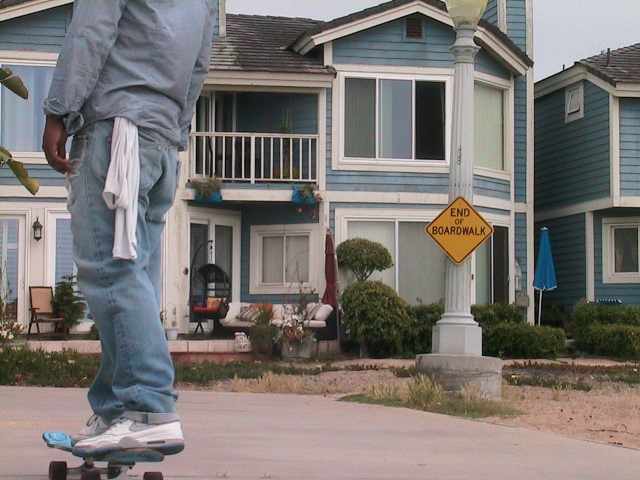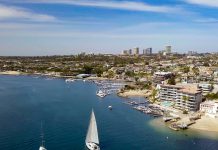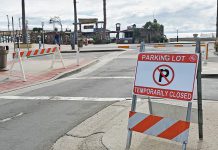
— NB Indy file photo ©
Boardwalk safety has been a hot topic for many years and last week it officially reached the Newport Beach City Council.
City staff presented possible regulation changes and plans for the oceanfront walkway on the Balboa Peninsula during a study session on April 23.
Councilwoman Diane Dixon, whose district covers the peninsula, said residents have been anxious for years for some change on the boardwalk to bring some relief. They have “long-held, pent-up feelings” and concern about the safety and rules on the boardwalk.
“I share your feelings on this, I think it is time to see some changes and improvements,” Dixon said. “I would like to see staff come back to council with recommendations on how to finally, at long last, after eight plus years, address the pleas from our residents to do something to improve safety on the boardwalk.”
Council took a few straw votes to provide city staff with direction before returning with recommendations, including: Explore changing the code to more closely reflect the California Vehicle Code; consider possibly banning surreys; look into changing the rules regulating e-bikes; and consider widening the boardwalk in areas of heavy congestion.
Councilman Will O’Neill was on the fence on a few issues.
“I don’t know,” O’Neill said. “This is pretty tough admittedly because this is the ‘devil in the details’ issue and it’s really, really important to get the details right.”
The oceanfront boardwalk, the three-mile, 12-foot wide concrete walkway that stretches between E and 36th streets, is one of the most popular recreational features in the city, said Public Information Manager Tara Finnigan, “no question about that.”
It’s also used as a transportation route up and down the peninsula, she added. There are various types of vehicles that use the boardwalk, including many that are not allowed by city code, like skateboards, electric scooters, and surrey cycles
Dixon did her own “boardwalk bicycle tour” recently. She saw all of the banned transport methods, she said. People are often distracted, creating more of a hazard on the busy walkway.
“Safety is our number one concern,” Dixon said.
Staff recommended that the city do a “code cleanup” of the section relating to the boardwalk.
At the top of the list of concerns: Speeding. The 8 mph rule is often broken.
In September, city staff recorded speeds on the boardwalk, which City Traffic Engineer Tony Brine called “fairly accurate,” but “not exact.”
During the hour-long test period they counted 44 bikes with an average speed of 9.5 mph. The max speed recorded on a bike was 14 mph. They also noted two users on skates (7.5 mph average) and two on skateboards (10 mph average).
Residents agree that speed is a big part of the problem.
Fred Levine, a 30-year peninsula resident, has seen a “tremendous” number of accidents on the boardwalk. With all the traffic, including motorized vehicles that can reach up to 20 mph, it’s a safety issue, he said.
Levine invited the council members to come spend a couple days over the weekend at his home facing the boardwalk and witness firsthand what happens along the popular pathway.
“You won’t believe what goes on,” he said. “It’s the 405.”
Others suggested e-bikes should be banned outright from the boardwalk.
“Electric bikes just don’t work on this particular path,” said Peninsula resident Maureen Cotton. “It’s not banning it for the whole city, it saying, ‘On this path we can’t have it. It’s not safe.’”
Jim Mosher reiterated a previous suggestion by another resident to deploy the interactive speed signs that display how fast the upcoming vehicle is traveling.
“There’s no shortage of information telling people that they should not go over 8 mph, but most people have no concept of what that is,” Mosher said. “I think if they actually saw the speed they were going they would be more respectful of the limit.”
Another major issue is enforcement, according to residents, including Levine. Police need the power and resources to enforce the rules and “stop the lunacy” on the boardwalk, he said.
Taking the lead on patrolling that area are the officers on bicycles, the Peninsula Enforcement Team, said Newport Beach Police Department Deputy Police Chief Dennis Birch.
“We see the boardwalk as part of our larger presence down there on the oceanfront and the peninsula,” Birch said.
During a year-long study period that ended on April 30, police issued 271 citations for specific boardwalk code violations. A big majority of those are skateboarding, making up for 171 of the citations during that time period. Others include: 29 for operating a surrey on the boardwalk, 28 miscellaneous (no helmet, bike on pier, no reflectors, etc.), 26 for unsafe operation, 15 for excessive speed, and two for motorized scooters.
Police have also recently put together a boardwalk “ambassadors” program, which consists of civilians handing out informational pamphlets on the boardwalk a few times a week. The ambassadors help educate people about the speed limit and other rules on the boardwalk, Birch explained.
“Generally just to be a good neighbor out there,” Birch said. “I think they’re having an impact.”
In the presentation, staff explained they want to “flip” their approach and specify in the city code what’s allowed instead of only detailing what’s not, Finnigan said. It would make it easier when something new is introduced, so that it would be prohibited until staff can study it and Council can review it.
Councilman Jeff Herdman, a retired educator, said the last two schools where he worked as principal also took a “reversed” approach to rules. They told the kids what they could do, instead of what they couldn’t do, he explained.
“The results were phenomenal,” Herdman said, “really, really positive.”
There is also a lot of signage telling users what not to do.
Along the boardwalk there are about 120 warning and informational signs, Brine noted.
“There’s a plethora of signs,” Dixon said.
There needs to be a better form of communication, she added.
An area that might benefit from that is the “intersection” where the boardwalk “essentially ends” at E Street, staff noted. Users exit onto a narrow street with parking on both sides and the sidewalk marked with “no bicycle riding” stencils.
Dixon also brought up the transition section as an area that needs attention. Bicycle and vehicle traffic meet and both come “shooting” into the street, she said. Flashing lights, bumpy surfaces, decorative boulders are just a few ideas that could get cyclists attention and stop or slow them down, she said.
City staff also hopes to work with the businesses about segway tour groups, which residents are sometimes “intimidated by,” Finnigan explained. They hope to agree on some regulations, which may include group size, routes and hours. They have also started a conversation with shop owners about surreys, she added.
Dixon was on board with the plan to meet with the surrey rental operators.
“Let’s talk and see if there is a solution that can be constructive and create a level playing field for all,” she said. “Let’s work with the owners to come up with a solution that everyone can support.”




